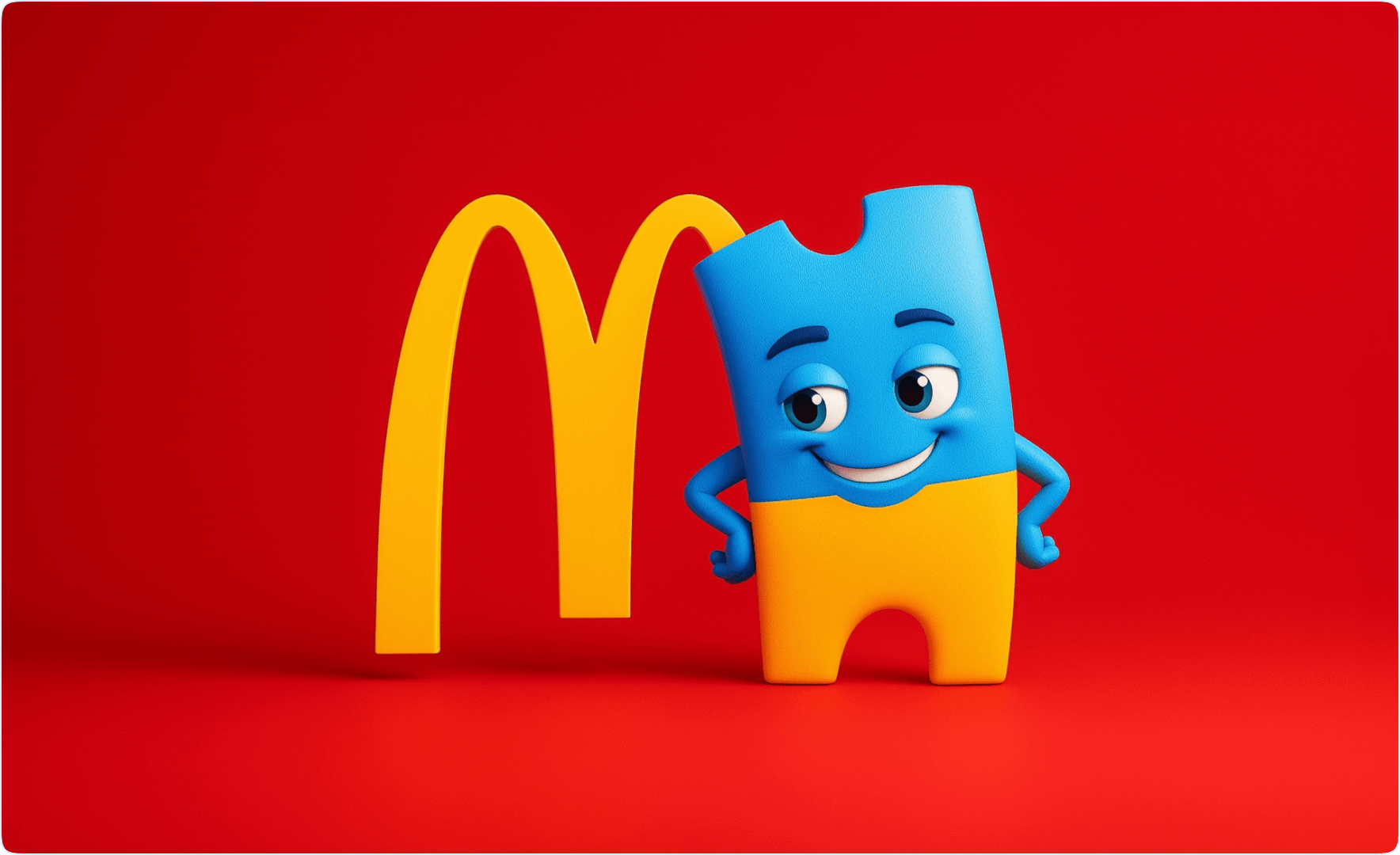11 Main Types of Marketing Games

Marketing has a short window to grab attention, and an even shorter one to keep it. At the same time, traditional marketing tactics are starting to feel a little… flat. Endless email blasts, static banners, and cookie-cutter social posts don’t make people instantly interested like they used to.
That’s why more brands are skipping these boring approaches and choosing marketing games.
Yes, strategic, goal-driven marketing games that get people to interact and actually enjoy your campaign. The options are countless: spinning a wheel for a discount, cracking open a mystery box, or answering a quiz to win a reward. Gamified content is constantly changing passive scrolling full of inattention into real engagement.
Moreover, games are quietly becoming one of the most effective tools in modern marketing that drive real business results. They boost lead capture and conversions, as well as improve customer retention and distribute promo codes at scale. In the end, they ultimately boost sales.
Level-up Engagement with Marketing Games
Explore interactive game formats that engage, convert, and retain customers.
book a personalized demoIn this article, we’ll explore 11 essential types of marketing games you can use across campaigns. Some are built for earning attention fast, others are perfect for nurturing loyalty or making product education feel fun. In other words, whatever your goal, you can always find and use a format that fits.
So, you’ll learn about:
- 11 powerful marketing game formats (with real use cases).
- Which games work best for specific marketing goals: education, engagement, loyalty, or conversion.
- Why gamified campaigns outperform static ones.
- When to plug into Winday’s pre-built formats to go live faster without sacrificing impact.
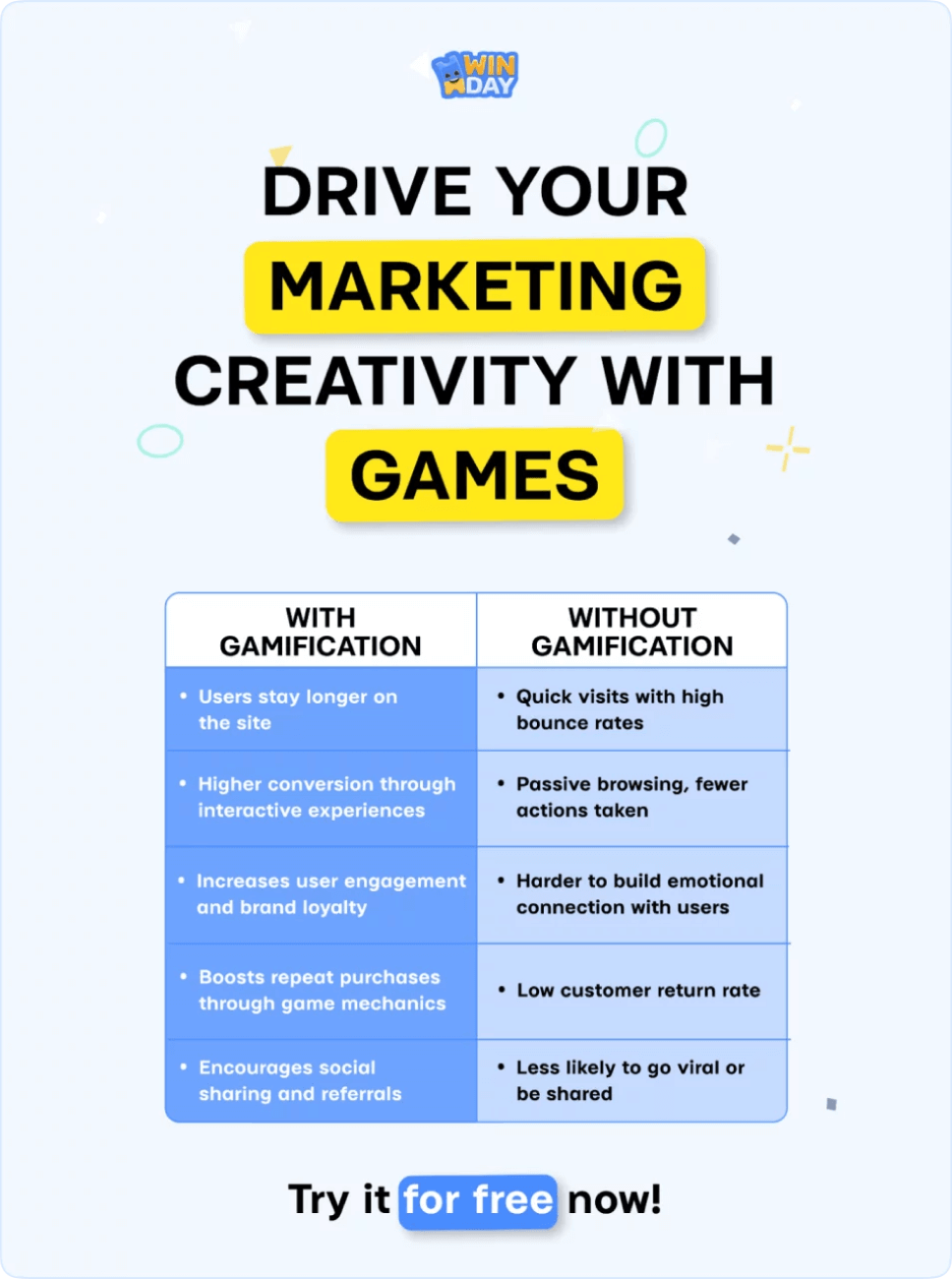
Winday offers a lot of gamification and marketing games options.
What is the Marketing Game?
A marketing game is an interactive digital experience designed to engage users while helping a brand achieve a specific goal. It can be something like collecting leads, raising awareness, or driving conversions.
There are many types of marketing games to choose from. You can find and deploy spin-to-wins, scratch cards, trivia quizzes, pick-a-box challenges, and more. Some, like Instant Games, are designed for fast interactions with immediate outcomes (perfect for delivering quick value). Others, like Tournament Games, focus on longer user engagement through ongoing contests or leaderboards.
But no matter the format, the idea is the same. To offer a playful experience that delivers value to the user, while nudging them toward a business result. Unlike traditional ads or static landing pages, first and foremost, marketing games invite participation.
What can online marketing games actually do? Quite a lot:
- Distribute coupons and promo codes interactively, but also give a chance to track them
- Generate leads by asking for contact info in exchange for a chance to win
- Boost brand awareness by getting users to interact and share
- Improve engagement and retention by keeping users coming back
- Build customer loyalty through rewards and repeat play
What gives these games a big advantage over traditional marketing is their grounding in behavioral psychology. Most, if not all, the games are using what’s called a habit loop. This is essentially a cycle of trigger, action, and reward that motivates users to play again.
This makes marketing games naturally more engaging and more appealing to users than traditional content. It helps brands not only with the number one task every marketer is after – getting attention. But also with the harder part: keeping it.
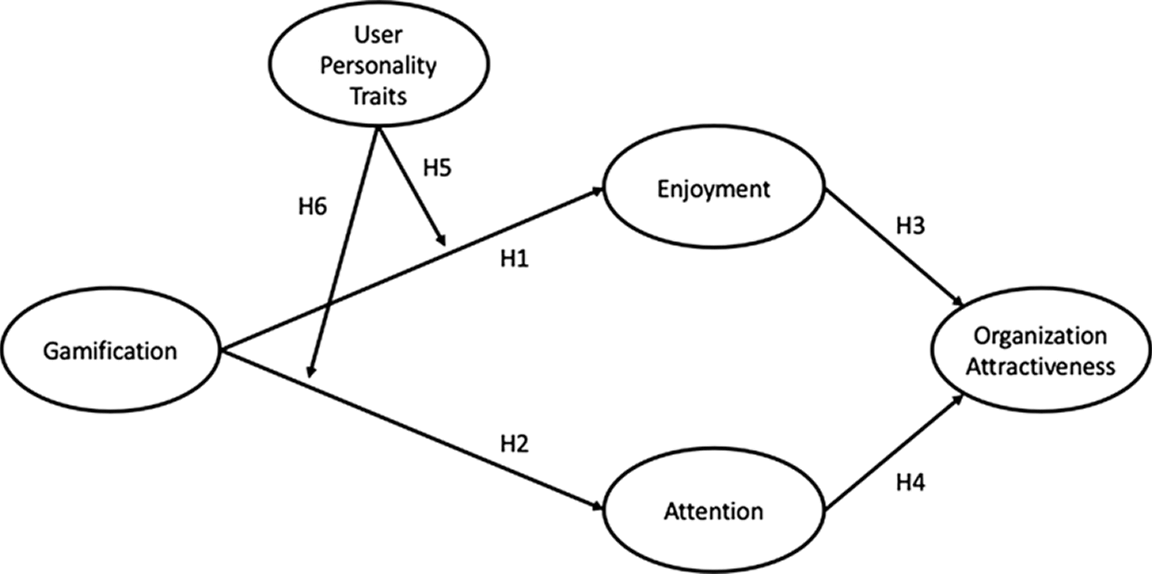
This diagram is a model that explains how gamification can make a brand more appealing.
11 Main Types of Marketing Games for Customer Engagement
Marketing games come in many shapes and sizes, which makes them perfect for literally any marketing goal you might have. Maybe your campaign needs a single-day boost or a long-term loyalty engine. Well, no problem! In both cases, you can rest assured there’s a game format built for that goal.
This variety is precisely what makes interactive marketing games so effective. And when done well, they’re more than functional, which is, frankly, an advantage for business rather than customers. They’re also fun, which is an advantage for users. People want to play them, and that makes them one of the most natural and scalable ways to create engagement today. In fact, 65–68% of users report that gamified systems influence their purchasing decisions.
In this section, we’ll walk through 11 major types of marketing games, each one customized to meet a specific goal. It could be anything from lead generation, retention, or brand building, to sales promotion campaigns.
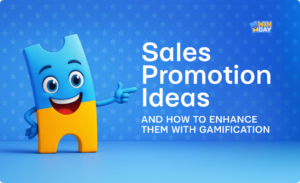
We’ll take a deep look at each format and explain:
- How it works, and what are the core mechanics behind the game
- What it delivers in terms of benefits for brand and customer
- Where to use each type of marketing game
1. Instant Win Marketing Games
These interactive marketing games give users a chance to win something without waiting too long. The prizes vary, but commonly they include a promo code, free shipping, or a product sample. Instant Win games are built on familiar mechanics from match-2, match-3, draw-3, and bubble shooter. These fun marketing games take literally seconds to play but create strong emotional payoff.
Winday offers ready-to-use formats for these kinds of branding games, automatically distributing prizes and promo codes to users once they complete the mini-game. You can choose game mechanics, gameplay balance, skin selection, and customize your code settings. The experience of the game itself is very adrenaline-filled, exactly what customers expect these days from online marketing games.
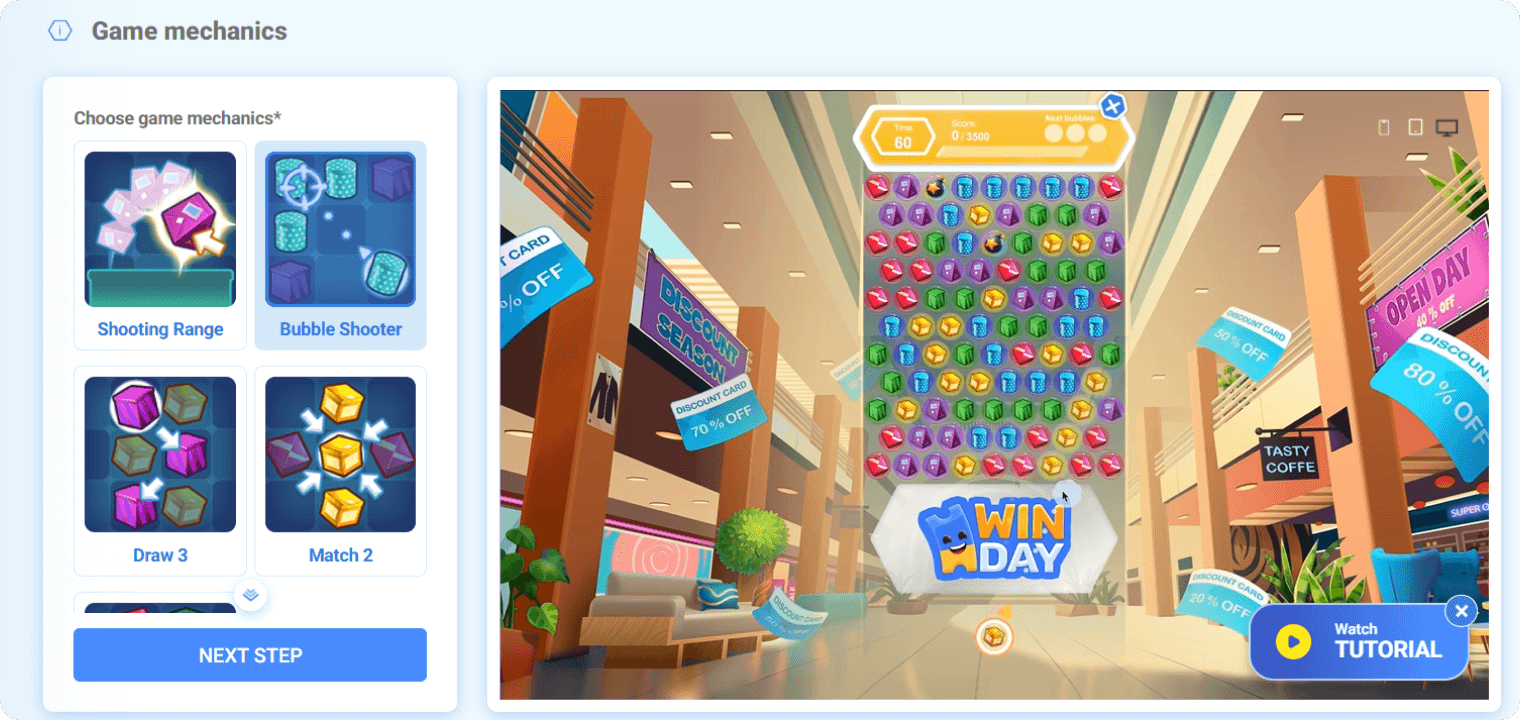
You can choose game mechanics in the Winday admin panel at the very beginning of setting up an Instant Game.
💡 Did You Know?
The “instant win” model began in 1974, when computer scientist John Koza and marketer Daniel Bower developed the first scratched‑off lottery cards for the Massachusetts State Lottery, a format that revealed prizes immediately and sold thousands in the first week.
Benefits:
The psychology behind instant games is simple: immediate rewards create motivation and keep it high. When customers know they could win something in just a few seconds and literally a few taps, they’re far more likely to invest their time in that.
This makes Instant Games perfect for collecting leads, boosting engagement, and nudging customers toward a purchase. These games are light and playful, and they don’t have a pushy, often demanding feeling that traditional ads give you.
Use cases:
Perfect for B2C campaigns, Winday’s Instant Games offer highly engaging, ultra-short challenges that users can complete in just a few seconds. These mechanics make it easy to plug into key customer moments across the funnel. It mean, you don’t need downloads or deep onboarding.
For example, businesses can introduce:
- Shooting Range: Let users “shoot” at moving targets to win discount codes. It is a solution for pre-sale teasers.
- Bubble Shooter: This mechanic suggests users pop matching elements for a prize; use it for email campaigns or retargeting banners.
- Draw 3: A quick match-three challenge where successful plays get a coupon or freebie. If you need an instant game for post-checkout or loyalty apps, that’s your choice.
- Match 2 or Match 3: A memory-style game where finding matching pairs leads to an instant reward. You can use this one for gamified onboarding.
In every case, the goal is the same: grab attention, deliver value, and convert traffic into action with these branding games.
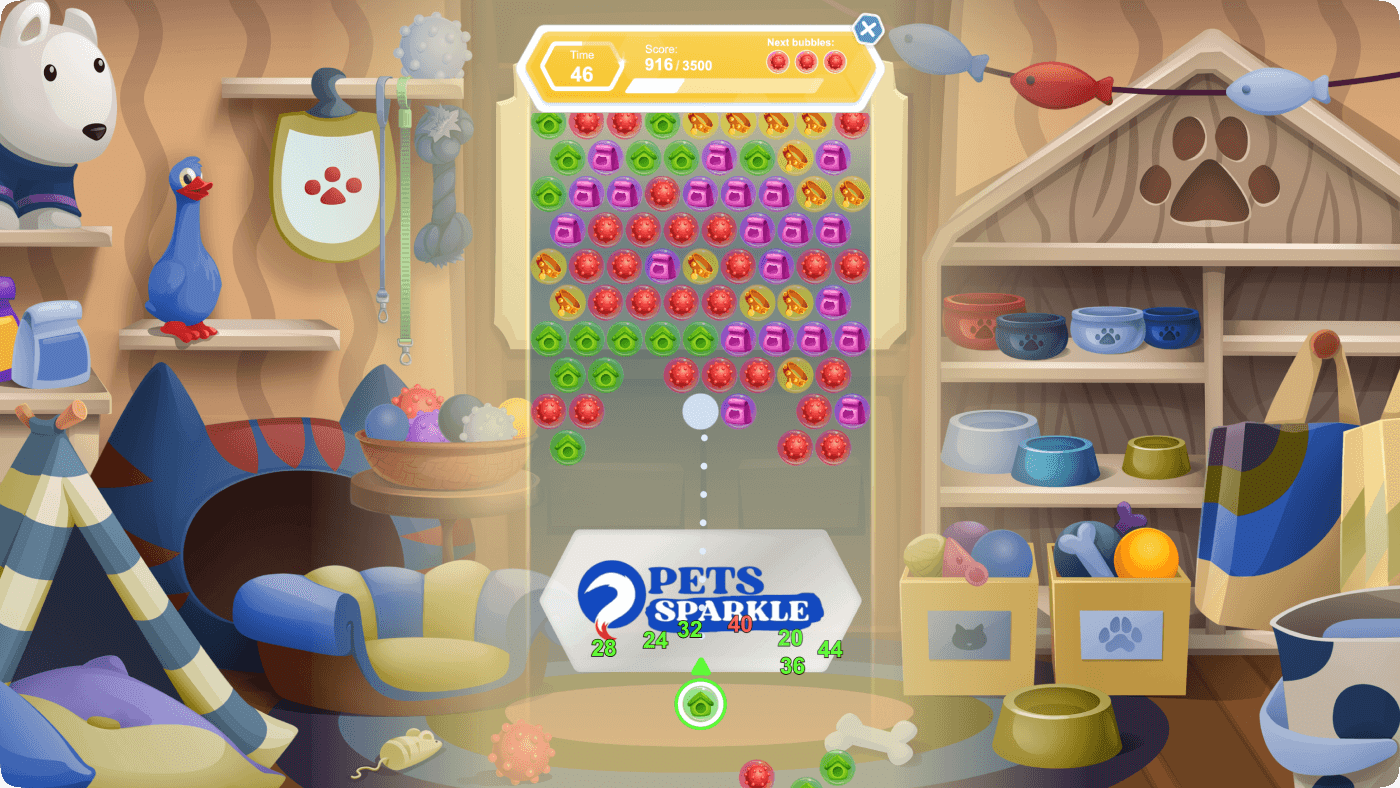
Example of Bubble Shooter branded game created on Winday.
2. Tournament Games with Ongoing Contests
Tournament Games are designed to keep users engaged over a longer period by combining gameplay with real-world purchase incentives. Here’s how it works on Winday:
- After completing a transaction (it doesn’t necessarily have to be online; an in-store option is also available), customers receive a unique participation code.
- This code gives them access to a branded online tournament game. The duration is completely up to you, and it can last from a few days to a month.
- Inside the game, users compete in skill-based challenges to get a higher score.
Every player sees a live leaderboard, which creates healthy competition and encourages repeat visits. Winday, however, takes it a step further.
If a customer makes another qualifying purchase, they receive an additional code that acts as a booster and gives bonus points or extra plays. This repeat-purchase mechanic was put here on purpose. It ties gameplay to sales and builds momentum throughout the campaign.
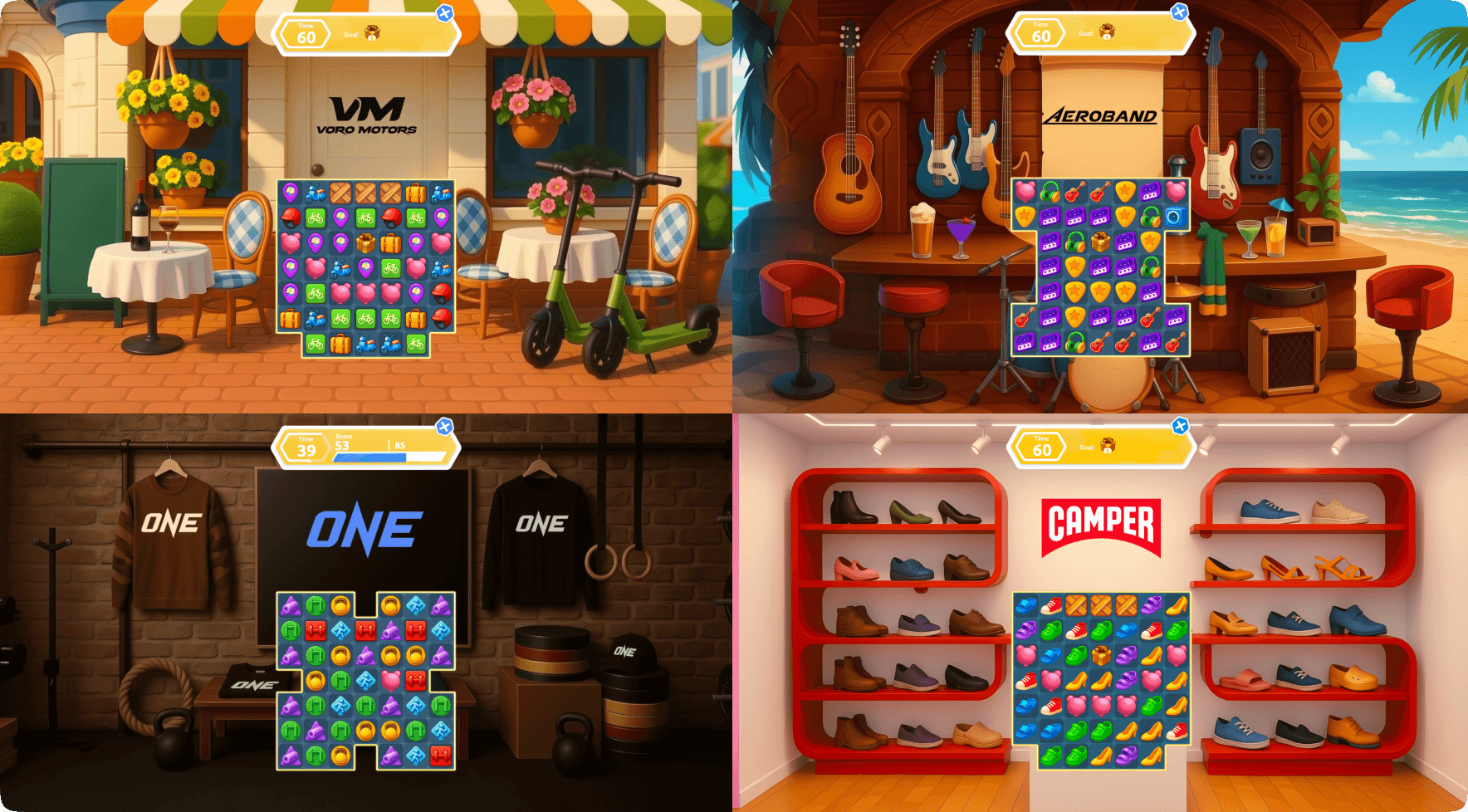
Examples of Match3 branded games created on Winday.
Because tournament formats reward high scores and consistency, users are motivated to return, replay, and improve. Since tournaments are by nature time-limited, competition adds a very strong sense of urgency. Besides, the presence of a public leaderboard also brings unexpected benefits: a sense of community and challenge. Yes, prizes can go to top scorers, lucky participants, or daily winners, but the structure of this gamification mechanism keeps energy high and participation ongoing.
Benefits:
The whole idea behind Tournament Games is to provide a sense of extended engagement. Unlike Instant Win games designed for quick action, here, customer interaction is not short. On the contrary, it is a multi-day experience.
Don’t forget that they have high viral potential. Simply because existing players share their progress, or they might challenge their friends. These actions are not echoing in the silence. They may look simple and don’t reveal their organic reach potential. And yet, they are there.
Moreover, stats only back it up. Gamified content is shared up to 12× more than non-gamified content, and campaigns can deliver a 100–150% jump in user engagement.
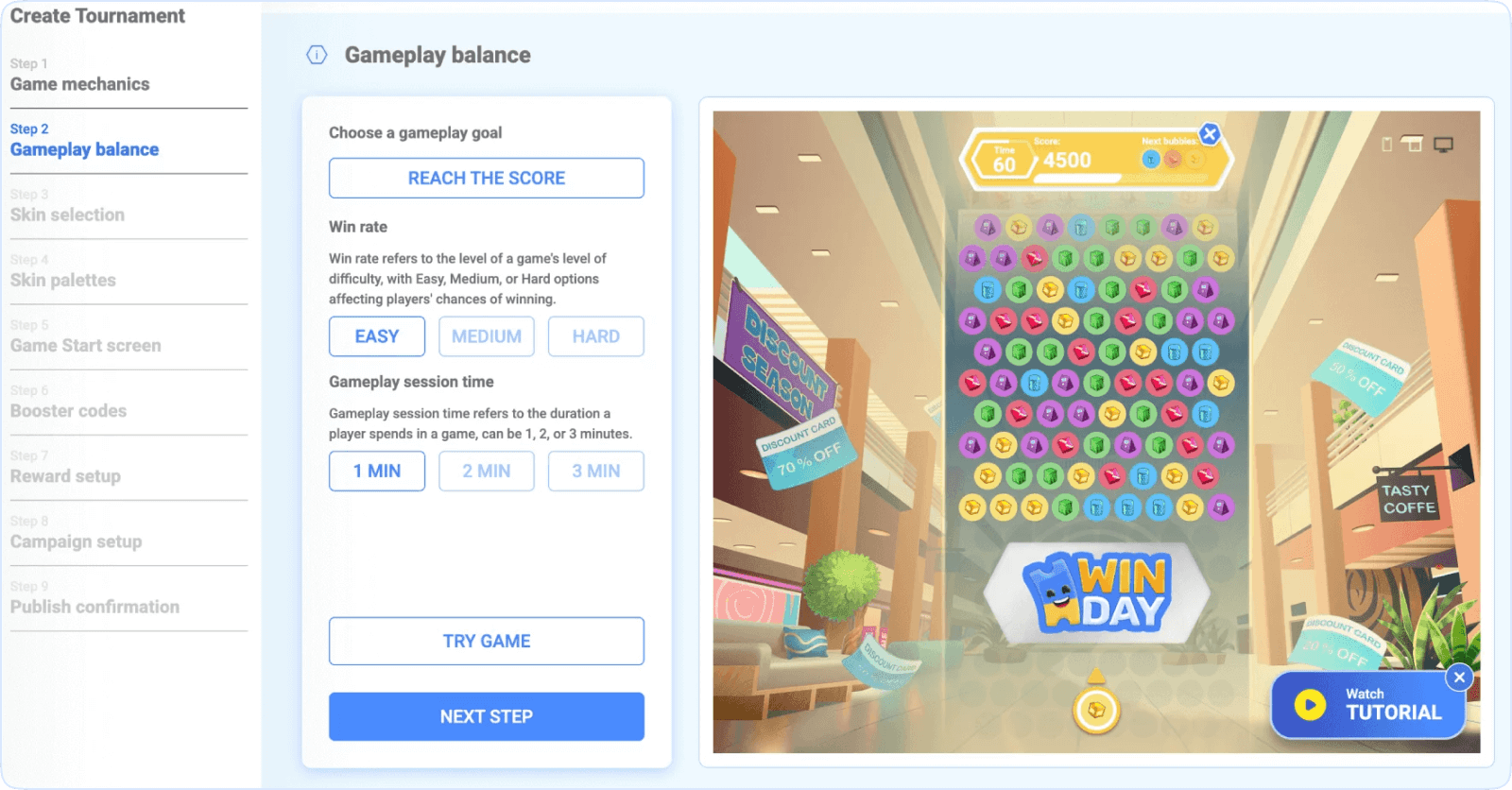
Tournament creation dashboard on Winday.
Use Cases and Examples:
Product launches are one of the most common ways of using tournament games. Brands are giving early customers exclusive codes that tie into the campaign. Holiday-themed contests are another popular choice, and you’ve probably seen that many times. For example:
- Countdowns to Christmas.
- Halloween challenges.
- Valentine’s Day tournaments.
Even B2B brands have used this format around trade shows, fiscal milestones, or industry-specific events to activate leads and create or enhance interest with gamified interaction.
Create Tournament Game
Explore Winday’s Gamification Platform totally for free. Create, publish branded tournament now!
start your free planEssentially, Tournament Games are perfect for brands looking to connect gameplay with repeat sales and some social buzz. It is one of the most strategic types of marketing games for long-term customer engagement.
📘 Pro Tip:
Tournament games work best when there’s a clear reason to return. So think in phases, not just one-off prizes. Use daily challenges, countdown mechanics, or progressive rewards to keep players coming back. You don’t need a huge budget; just structure it so each visit is like progress.
3. Scratch-and-Win Games
Everyone at least once or twice scratched the surface of a piece of paper, hoping to discover a winning image or a combination of symbols. This is an experience that kids value as much as adults cherish it.
In Scratch-and-Win games, users experience the same anticipation, but within the digital realm. The only difference is that users get to scratch a virtual card. Underneath, they can find everything from a discount code to a grand prize.
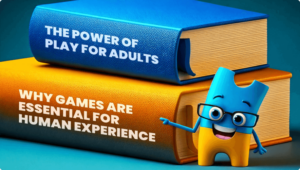
As you understand, the mechanic mirrors traditional scratch cards. They are very simple, tactile, and, importantly, satisfying. But in this digital version, everything is automated. The backend handles reward logic and delivery, making it easy to run at scale across devices.
Benefits:
Since the experience of scratching to win is familiar to most people, this game builds on that known, satisfying mechanic. Another advantage is that it’s incredibly simple and quick to deploy. Plus, the sense of surprise about what reward lies beneath the scratchable area adds a pleasant suspense that’s inherently fun.
Use Cases and Examples:
Pepsi ran a holiday-themed Scratch-and-Win campaign that turned a simple soda purchase into a game. Customers could scan QR codes printed on specially marked cans, which unlocked a digital scratch card on their phones.

Pepsi’s digital scratch-off game with a cash prize ranging from $5 to $25,000.
The goal was to match three Pepsi globes, just like you would on a lottery card, to reveal a prize. But Pepsi didn’t stop at giving away rewards; they made the experience more interactive by letting people choose WHAT to do with their win. You could keep the prize, gift it to a friend, or even donate it to charity.
This approach worked well because it made buying Pepsi part of a playful experience. The scratch and win mechanic created anticipation and excitement. Plus, the option to give or donate added a social and emotional twist that encouraged people to share the campaign with others.
As we said at the beginning of this article, the more static marketing materials are, the less fun they are for the users. So, generic sign-up incentives can be replaced by a Scratch-and-Win game as a pop-up. Visitors are invited to “scratch” for a mystery reward in exchange for their email. What usually increases opt-in rates here is the feeling that reward is earned, not just given.
What are some other smart uses?
- Run a scratch card as part of a cart-abandonment email. A logic behind this approach suggests that a surprise offer might nudge customers back.
- Tie it to referrals, where both referrer and referee get “scratch to win” bonuses after a successful invite.
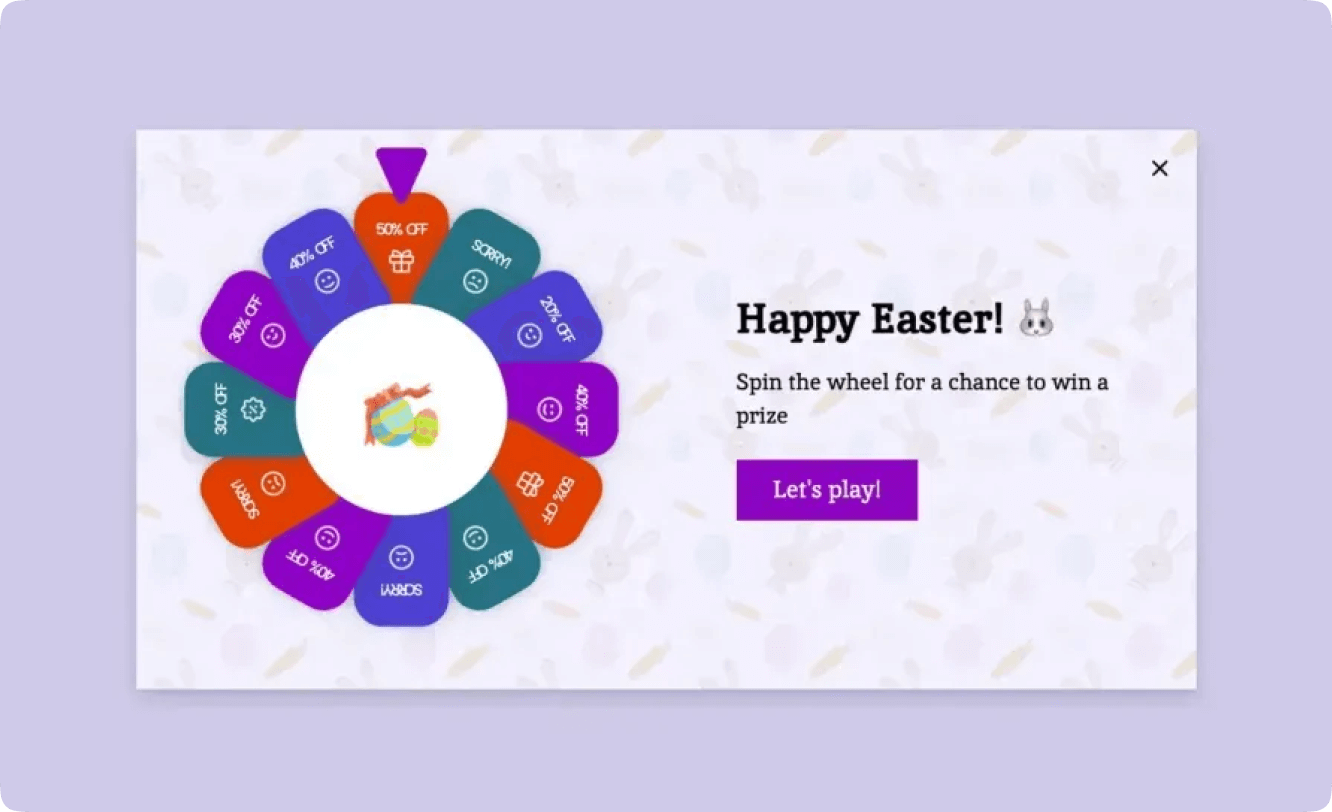
Email pop-up with spin the wheel game.
4. Wheel-of-Fortune Games
At its core, it’s simple: the user taps a button and watches a colorful wheel spin, waiting to see where it lands. That short moment slowly builds excitement. And because the rewards are randomized, no two spins will be the same. Some wheels offer equal odds, others are weighted toward specific prizes, making it easy to set up small and high-value outcomes in one game.
Benefits:
This format does what all marketers are after: draws attention immediately. It’s simply hard to ignore, even on a busy screen. The randomness feels fair, the motion feels satisfying, and there’s always a reason to try again. Common sense says, “Maybe the next spin will land on the big one?”
Mechanics involve anticipation and visual excitement, which is great for variable prize structures.
Use Cases and Examples:
This FreshFood Market campaign is a classic Wheel-of-Fortune style game. Its main goal is two-fold: to interest and keep customers coming back every week. Could they offer static coupons? Yes. Yet, it might have failed. Instead, the brand gamified the discount experience with a digital spin wheel.
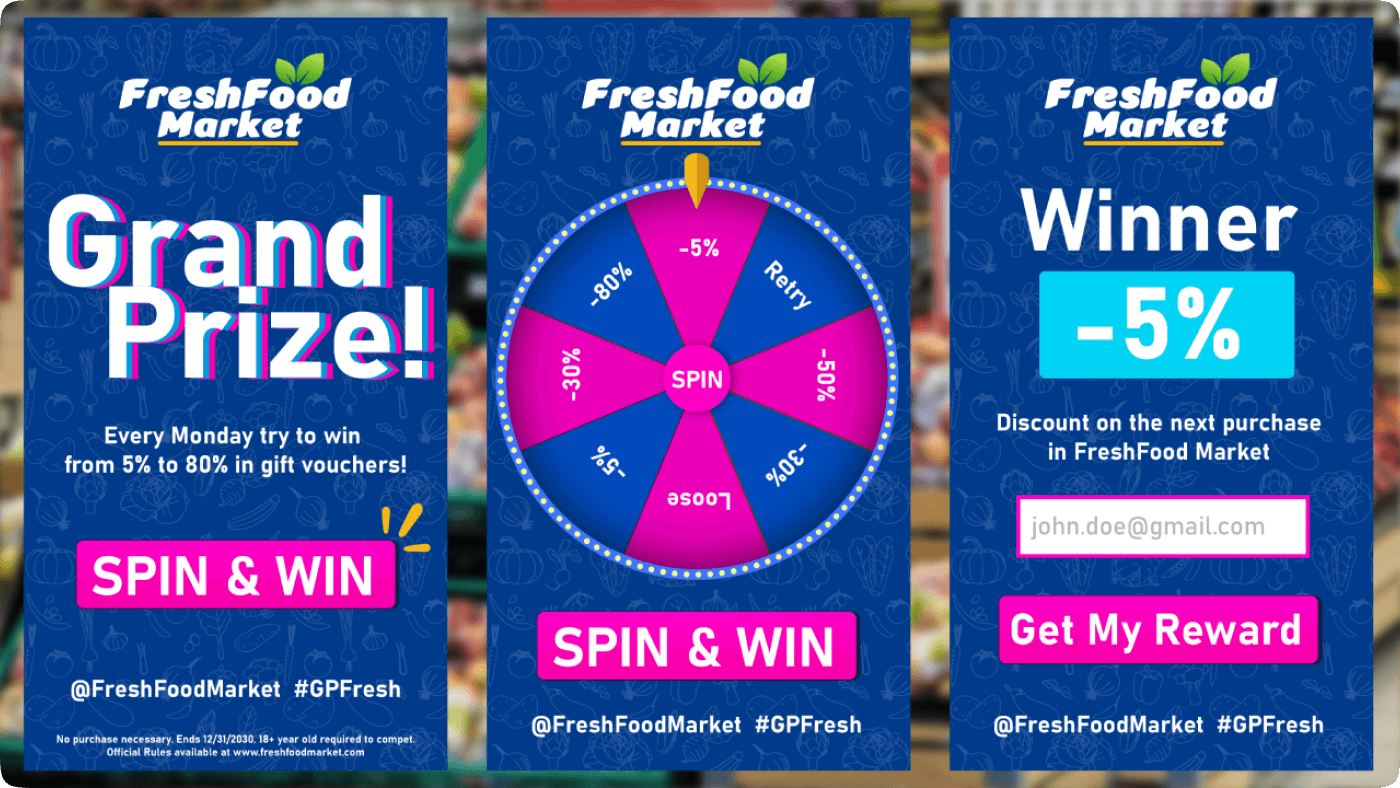
“Spin & Win” discount game used for interactive promotional marketing by FreshFood Market.
Here’s how it worked in practice: customers could join every Monday and hit “Spin & Win” for a chance to score discounts ranging from 5% all the way up to 80% in gift vouchers. The spinning wheel added an element of suspense and fun. Would you get a small prize, a big one, or have to retry? Once the spin was done, winners could instantly claim their discount by entering their email, which not only secured their prize but also helped FreshFood Market build its customer database.
This kind of game worked for a reason: a routine promotion becomes a playful moment. People are far more likely to share a spin-the-wheel campaign on social media than they are to talk about a generic coupon code. It also drives repeat engagement since customers know the game refreshes weekly, keeping them in the brand’s orbit.
It’s a strong example of how interactive games for brands make customers earn them in a way that feels entertaining and rewarding, which is exactly why it’s considered one of the best marketing games for generating excitement in everyday shopping.
Furthermore, it showed how interactive marketing games can make everyday products different. They can be conversation starters and games for marketing campaigns can build engagement and goodwill. No wonder scratch-and-win remains one of the best marketing games when a brand wants quick attention and strong participation.
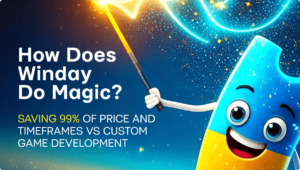
5. Quiz and Trivia Games
Quizzes and trivia games are among the most popular tools brands use when they want to combine fun and promotion. As you know, scratch-and-win or spin-the-wheel, rely mostly on luck. Quizzes, on the other hand, challenge customers to think, test their knowledge, and feel smart when they get things right.
People love answering questions, especially when they feel like the quiz “gets them” or teaches them something new. And it is no wonder that some of the most effective marketing games online include trivia challenges. That small sense of achievement is powerful because it keeps people engaged longer and makes them more likely to share results with friends.
With this format, users go through a set of questions, which can be fun (timeless movie trivia or personality tests) or more brand-specific (product recommendations or knowledge checks).
Depending on how you set it up, the quiz can lead to a score, a reward, or personalized content. It can also unlock gated offers. For example, something like “Answer 3 questions to reveal your discount” is a good idea.

A personality quiz game used for interactive marketing, specifically known as a product-matching quiz or brand personality quiz.
Benefits:
Quizzes are familiar and genuinely fun when you make them in the right way. They are like interactive games for customers. Think about it: there is zero pressure on people, and, maybe rather in a low-key fashion, let them learn something new about themselves.
They’re also a great way to guide users through product discovery and not making out of it a boring sales pitch. They’re shown what fits customers based on their own answers.
And because people love to share results (especially if it says something interesting about them), this format often spreads well on social media. No need for an extra paid boost for business.
📘 Pro Tip:
Don’t just stop at the quiz result, but try using it as a launchpad. Trigger personalized follow-ups based on answers (e.g. tailored emails, product bundles, retargeting ads). Think of it as a segmentation tool.
Use Cases and Examples:
What interesting examples are there? More than you think!
Sephora has mastered the use of quizzes as both a marketing tool and a sales engine. They could use generic product suggestions for customers, but they came up with a much better solution. They use short, interactive quizzes that feel more like a conversation than a promotion. For example, their Skincare Finder Quiz asks about skin type, sensitivity, and lifestyle habits. In a few clicks, users get personalized product recommendations that feel tailor-made. The same approach appears in their Fragrance Finder and Foundation Shade Match quizzes, which solve real customer problems: “What scent fits me?” or “What’s my perfect shade?”
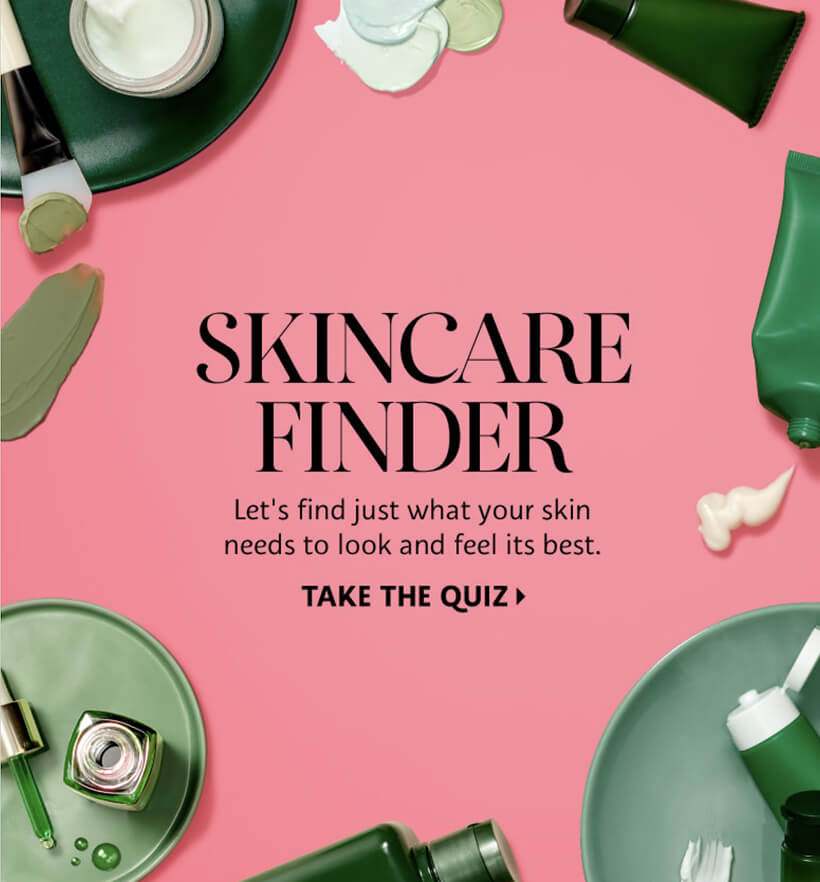
From a marketing perspective, this works on multiple levels:
- First, the quizzes are fun. People enjoy answering questions about themselves, and they’re more likely to trust the results because they had a hand in shaping them.
- Second, they quietly capture valuable data. Every answer gives Sephora insights into customer preferences, which fuels smarter product suggestions and targeted campaigns later.
- Third, they drive direct sales. Shoppers don’t leave with a random coupon; they leave with a curated product list they’re more likely to buy on the spot.
This is what makes Sephora’s quizzes a textbook case of interactive games for brands. They solve problems, build loyalty, they generate conversions. It’s a clear example of why quizzes and trivia stand out as one of the best marketing games.
There’s also Netflix, which has experimented with trivia-style promotions to promote shows. For example, around the release of Stranger Things, Netflix launched themed quizzes that tested fans’ knowledge of the show. But they did more than that:
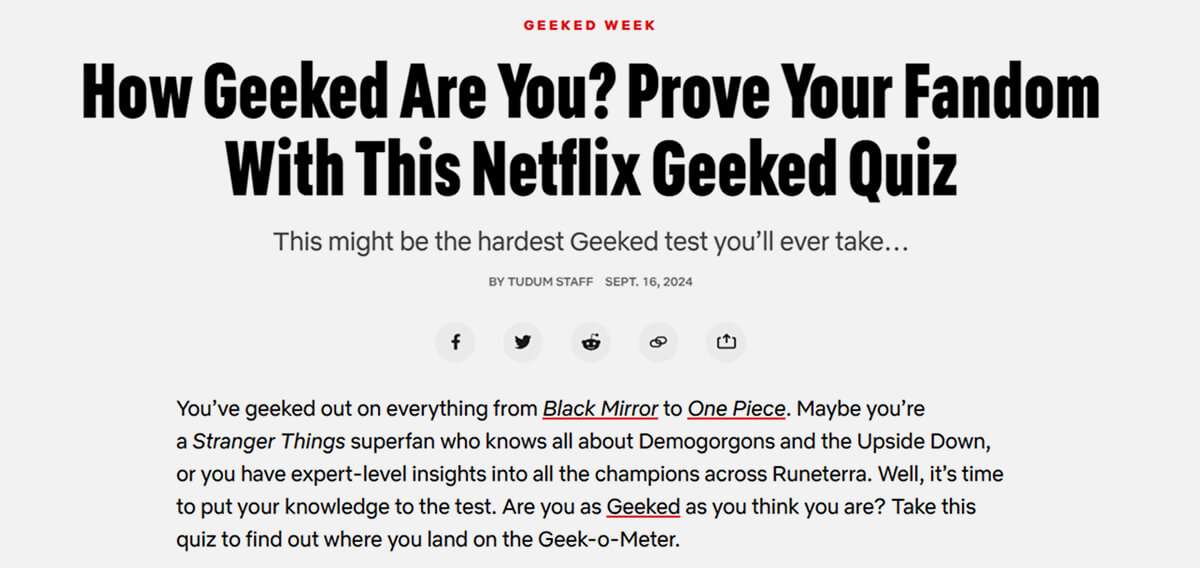
6. Puzzle Games or Knowledge Games
We all are familiar with good old word searches, Sudoku, and logic puzzles. These games have long-standing fan bases and are loved across age groups for a reason: they challenge the mind and feel satisfying to complete. When brands use this format, they can offer:
- Mini brain-teasers.
- Trivia challenges.
- Matching tasks that align with the user’s interests or even the brand’s products.
You can use these mechanics for pure entertainment, or combine them with educational goals. It is a good idea to teach users about features and benefits in such an interactive way.
Benefits:
It gets people to slow down and focus, which means more time spent with your brand. Moreover, it creates a sense of accomplishment, while other games rely more on chance. Who doesn’t love to crack a brain teaser, after all?
Finally, it positions your brand as clever and innovative. That’s an important thing in B2B or educational spaces.
If you’re exploring marketing games online, puzzle and knowledge formats offer long-lasting value. The education sector, tech, or finance, can benefit a lot from these types of games for brands.
Use Cases and Examples:
Brain-teaser promotions: It is a simple way to add depth to a campaign. You can offer a discount outright, but it won’t be the same if you invite users to solve a small puzzle first. This could be a riddle in an email, a pattern-recognition task on your site, or a timed logic challenge in a mobile app. The interaction encourages users to spend more time with your content, which exposes them to your brand message.
Microlearning gamification: takes a more structured approach, especially useful in B2B, education, or tech contexts. Don’t overwhelm users with full-length explanations or product tutorials. Rather, break information into short, game-like tasks. It can be:
- Multiple choice questions.
- Interactive diagrams.
- Mini-scenarios that teach users how to use a feature, or simply explain a concept.
The format supports repetition and gradual progress, which is ideal for onboarding new users or helping existing customers become more proficient.
Loyalty-based games for active users are designed for retention. Yes, rewarding purchases is a good idea, but if you have a loyal audience, why don’t you recognize them with more consistent engagement? As a result, a user might return daily to solve a new challenge, complete a weekly knowledge quiz, or take part in a month-long series of puzzles. Tie their progress to a points system, access to exclusive content, or maybe even tangible rewards. What is the point of these mechanics? To put it simply, they keep your existing user base involved in an ongoing relationship with the brand.
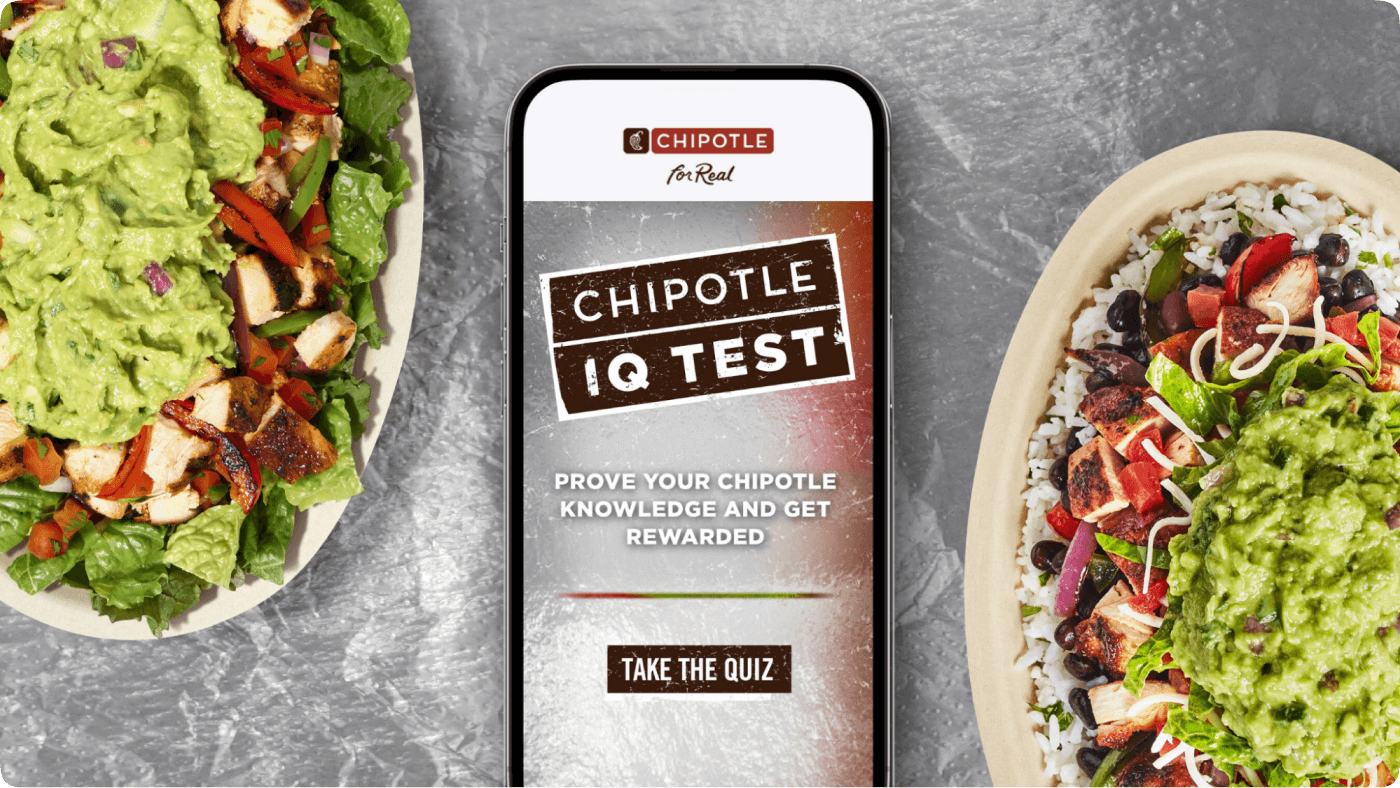
Chipotle’s IQ trivia engages fans with menu questions. It is a classic case of educating while generating leads.
7. Hidden Object and Memory Games
We’re all familiar with the sweet little rush that comes from spotting something hidden: finally finding Waldo in a sea of striped decoys, or matching a perfect pair of cards from memory before your opponent does.
These games may seem simple on the surface, but they are all about focus, observation, and the satisfaction of getting it right. In these games, players scan a crowded visual scene to locate specific items tucked away. You can choose what exactly you want to reward – speed or accuracy. Either way, the task feels intuitive, which is part of why it works so well.

Mr. Owl’s Valentine’s Day Candy Search is a hidden-image game by Tootsie where players hunt for candy-themed icons in a doodle scramble.
Benefits:
Anything that trains focus and attention these days has a metaphorical blue mark beside it. Since everyone wants to “fix” their attention span ruined by social media, a little gamified opportunity to train attention won’t be omitted.
On a simpler lever, this format encourages repeat plays for better scores. Players simply want to return and get more points.
You can sneak in brand or product visuals and don’t disrupt the user’s interaction with a feeling of pushed advertising.
Use Cases and Examples:
IKEA has leaned on this mechanic multiple times, with strong results.
One of their best-known efforts was the IKEA Museum Challenge in Madrid. The brand placed modern IKEA furniture among antique pieces in the Museum of Romanticism and challenged visitors to spot them. Online, the experience extended to Facebook 360° photos and Instagram Stories, where followers could play along virtually.
It was a clever idea: IKEA showed off the timelessness of its design. Plus, from a marketing perspective, they made a standard brand activation into a fun game of “spot the difference”.
In Portugal, IKEA ran the Hidden Tags Campaign, which invited customers to go hunting… inside their own homes. The idea was simple: every IKEA product has a label with a production code, usually hidden once the furniture is assembled. IKEA asked people to dig out those hidden labels, share them online, and compete to find the oldest IKEA item still in use.

More than 4,500 labels were submitted, with the winning item dating back to 1969. This transformed IKEA’s reputation for durability into a playful competition, and started a wave of user-generated content.
Finally, the Tiny Home Scavenger Hunt on Instagram pushed the hidden object idea into the digital space. IKEA scattered clues and puzzles across its feed and influencer posts. Users had to solve riddles, collect secret letters, and piece together a final password to unlock a chance to win a sustainable tiny home.
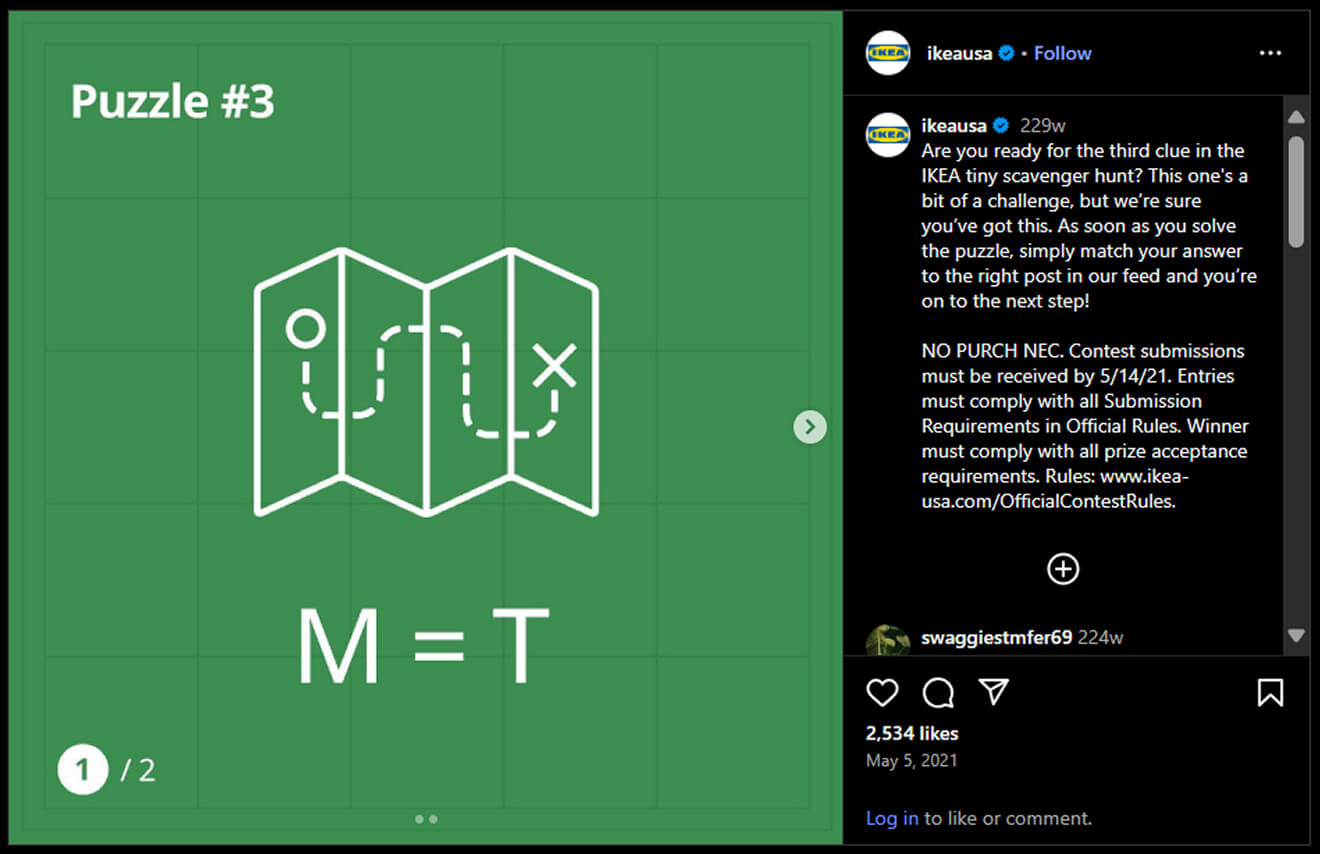
8. Casual Games: Matching, Platformers, Tapping, Arcade
If you are looking for easy games to attract customers, this is your choice. Casual games immediately reveal their nature by their name. Anyone can start playing them in seconds without tutorials. Simple actions needed – tap, match, jump, or swipe.
Their mechanics are also quite basic and usually include:
- Connecting tiles.
- Dodging obstacles.
- Tapping fast-moving objects.
- Racking up points in an arcade-style loop.
These games don’t ask much from the player, which is exactly why they’re so effective.
Benefits:
Casual games, as we mentioned before, have universal appeal because they are simple. There’s no intimidation factor. This low barrier to entry makes them very efficient for entertainment-first campaigns where the goal is to engage as many people as possible, quickly and easily.
Use Cases and Examples:
Fun marketing games built around casual mechanics are perfect for quick promotions or product-themed mini-games. You can add icons from your brand for a tile-matching game.
They also work well in Instagram Story promotions. A quick game can increase brand engagement or drive traffic with very little friction.
And for traffic campaigns, casual games are great at pulling people in. You give them something quick and ultimately enjoyable to play, and then direct them to a landing page or gated prize. Basically, you lead them from a fun experience to conversion.
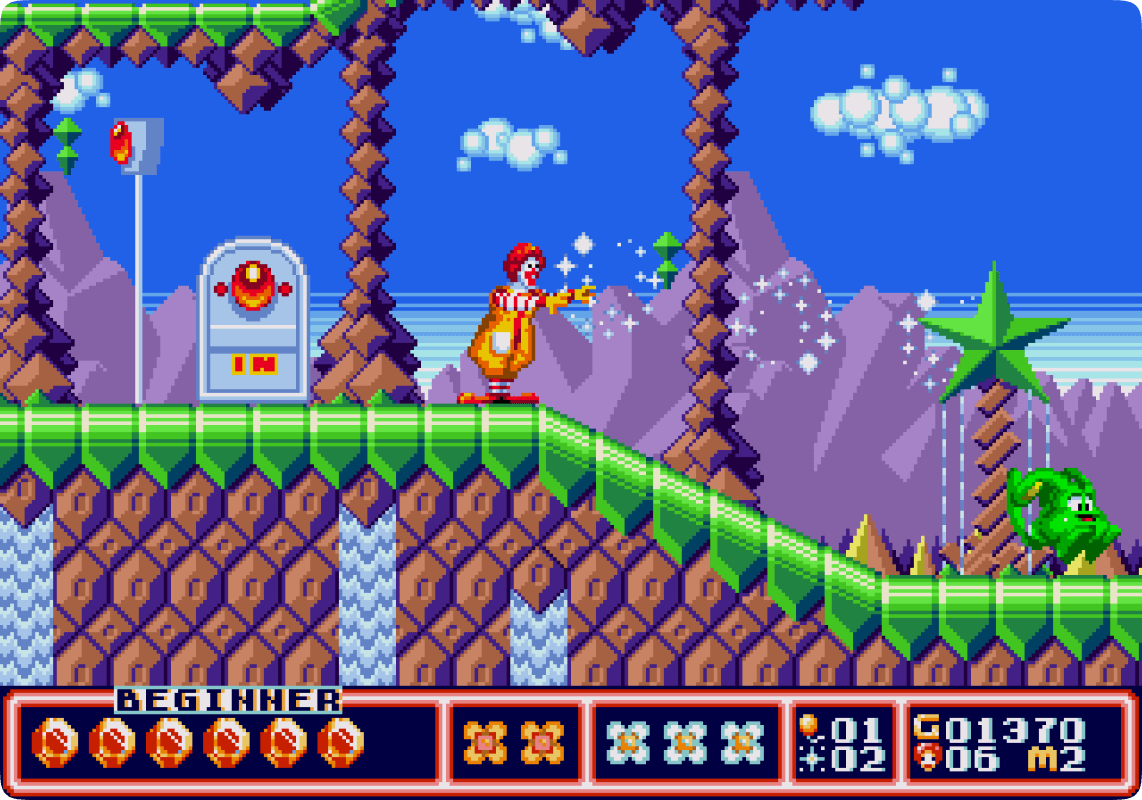
McDonald’s Treasure Land Adventure is a 1993 Sega Genesis game where you play as Ronald McDonald. Based on the McDonaldland campaign, the goal is to find lost map pieces and stop villains to uncover hidden treasure.
9. Strategy Games
Strategy games ask more from the player, but in return, they offer deeper engagement. Unlike quick taps or fast reactions, as we saw in the previous marketing games ideas, strategy games revolve around decision-making. It is common to ask players to build something from scratch, optimize a system, or manage limited resources to reach a goal.
The gameplay usually unfolds over a longer loop. Players explore, test, adjust, and learn as they go. Here, you don’t rely on speed, and you don’t use it as a gamification mechanic. The real zest is about thinking things through. Choose this format when your goal is to communicate more complex ideas or systems.
Benefits:
Strategy games hold attention longer than most formats, which gives brands more space to deliver a message.
These marketing games examples are great for B2B environments or industries where the product isn’t instantly understood. Why? Simply because you add a layer of interactivity and show people what your tool does. It doesn’t matter if your goal is to show workflow design or simulate outcomes; the user learns everything by doing.
The idea behind this is highly efficient. Since players invest time and mental effort, they tend to remember the experience, and, by extension, the brand behind it. That’s why these formats work so well as games for brands aiming to explain something complex without offering users endless sheets of text or dry videos.
Use Cases and Examples:
The common case is “build your own agency” or “manage your budget” simulation. These are the games where users allocate time, staff, or money and see how their choices play out. This is a good idea to use for marketing tools, service platforms, or SaaS products where the value is clearer when experienced firsthand.
It is also another good choice for B2B marketing. Such interactive games for customers can simplify complicated tools or features. Of course, you can give people a demo, but the effect isn’t the same as letting them try a gamified version themselves.
Strategy games also have a place in recruitment campaigns. You can design a simulation to real job tasks and give candidates a feel for the role, while you assess their thinking process.
In all of these cases, strategy games serve as effective games for marketing by creating real involvement.
10. Gamified Surveys and Interactive Experiences
Gamified surveys and interactive games for customers are changing the feeling of a form, quiz, or onboarding flow. For example, traditionally, you would ask users to fill out long, static fields. But is this really that interesting to fill out in the online reality already full of similar experiences? Of course, no.
Guide them through one step at a time, maybe add gaudy animations, conditional logic, and, obviously, friendly language.
It’s still a survey or data collection tool at its core. But its design takes away the boring part: users might answer a few questions, get a playful progress bar, see a result, and maybe even earn a discount code at the end.
In fact, these formats are now widely used as games to attract customers.
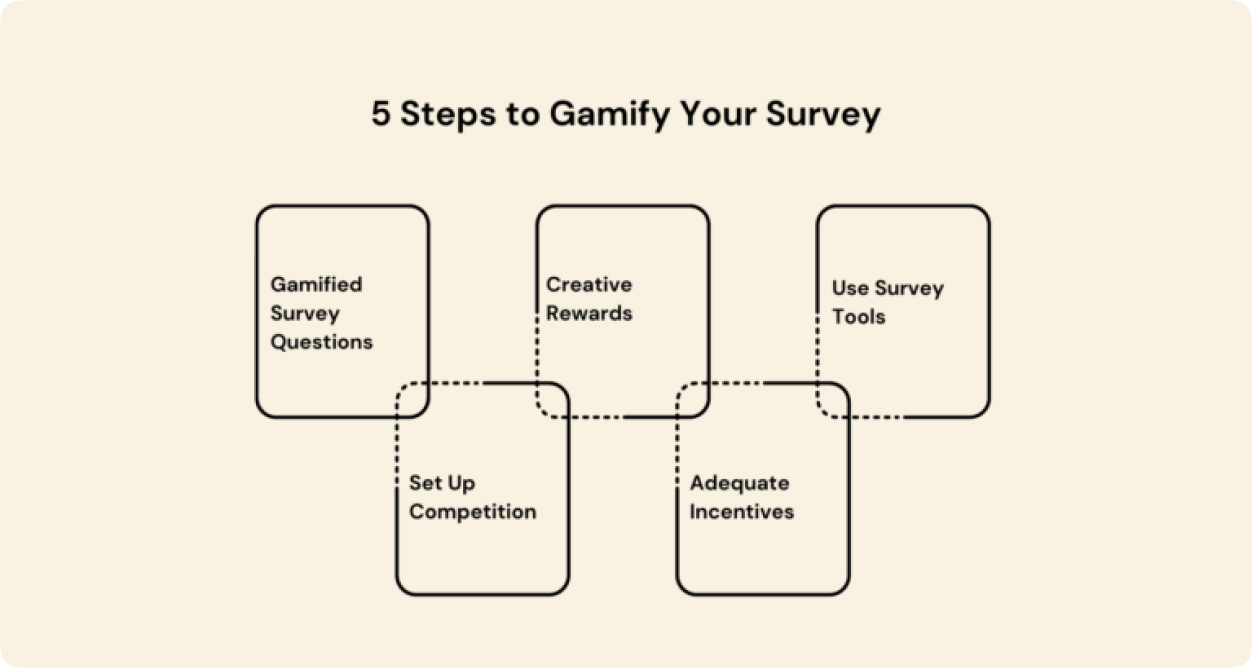
A visual from SurveySparrow outlines 5 key steps to gamify your survey.
💡 Did You Know?
Forms that open with a single, simple multiple-choice question achieve about 89% completion. That’s compared to 83% when they start with an open-ended question.
Benefits:
These interactive flows work because they respect the user’s time and attention. People are more likely to finish what they start when the process is not bulky and annoying. That’s why gamified surveys often lead to higher completion rates than traditional forms.
They’re also useful for creating more personalized outcomes. Whether it’s a product recommendation or, for example, a lead capture form, you can tailor what users see based on how they answer. In the end, it feels less like another generic funnel.
And finally, these games for marketing make data collection less intrusive. There are no questions that might look intrusive for info upfront. You guide the user to naturally provide it while having a rather lightweight experience.
Essentially, these are great examples of games for marketing in disguise that serve real business goals.
Use Cases and Examples:
- B2B onboarding quizzes: In this context, it can be an introduction to a new platform, basically an onboarding quiz.
- Consumer product finders: “Which coffee roast fits your style?” or “Find your perfect skincare routine”, are great ways to guide people to the right offer.
- Feedback loops that offer discount codes: After making a purchase or using a service, the customer answers a few short questions and gets a reward, like a discount code or early access to a new feature.
11. Games of Chance
Games of chance are marketing games where the result is driven mainly by luck, rather than the participant’s skill. Examples include lottery draws, mystery boxes, scratch cards, card flips, or dice rolls. In digital form, these mimic classic lucky-draw mechanics: you might open a “surprise box”, spin a wheel, or pick a card without knowing what’s behind it until after you commit.
Benefits:
The biggest draw of games of chance is the excitement that comes with unpredictability. People enjoy the “maybe I’ll win something amazing” feeling, even if the prize is small. That mix of risk and reward keeps them curious and engaged.
They also work well for large-scale campaigns because participation is quick and doesn’t require any effort. Anyone can try their luck without needing instructions or prior knowledge, which lowers barriers and encourages higher turnout. This simplicity gives them universal appeal across different audiences. Anyone, like casual browsers or loyal customers can enjoy it.
Another advantage is flexibility in prizes. Marketers can offer a mix of rewards, so that even if not everyone wins the top prize, most participants still feel satisfied and motivated to play again. There is a balance between accessibility and excitement is why games of chance remain a staple in offline and digital marketing campaigns.
Use Cases and Examples:
Kosas, a beauty brand, partnered with BoxyCharm to launch a mystery box-style campaign tied to a new mascara product. They invited BoxyCharm subscribers (over a million) to enter via email; 2,000 participants were randomly selected.
These people received unbranded mascaras, then were asked to guess the brand on Instagram. That launched a lot of buzz around the brands and also a lot of user-generated content was there. The campaign was less about skill, more about surprise and participation.
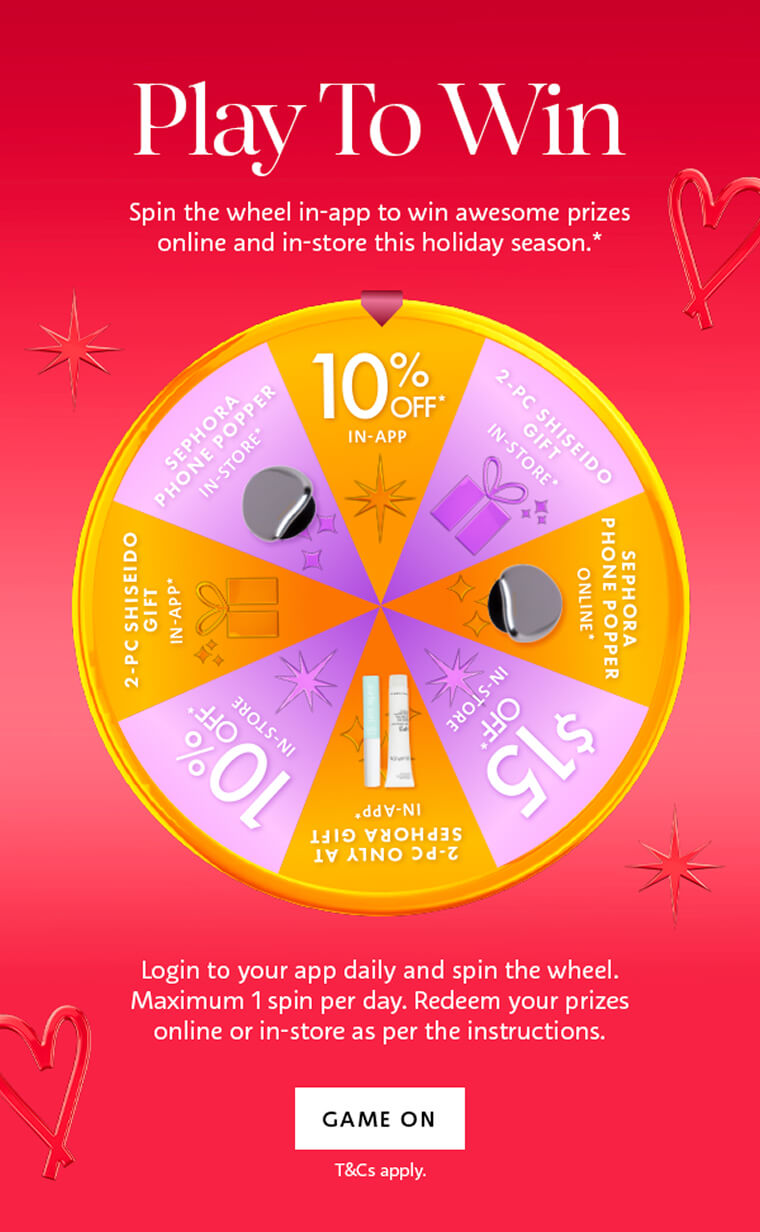
Sephora Singapore ran a “Spin to Win” campaign exclusively for members of its Beauty Pass loyalty program. Members were allowed one spin per day during the campaign period, as long as they were signed in to their Beauty Pass account.
The mechanic was simple: players tapped to spin a digital wheel, and whatever section it landed on determined their prize. Rewards included discounts, bonus perks, and free products, all redeemable with a special promo code provided in the app. The prizes were limited in quantity, so availability depended on stock levels.
Final Takeaways
Such experiences can be deeply strategic gamification marketing tools that plug into every part of your marketing funnel. Literally. You can implement different games from first touch to brand loyalty. For example, you can use Winday Instant Win games to attract customers at the top of the funnel.
Then, interactive marketing games can incentivize micro-conversions at the middle part of your funnel. They can complete a profile, refer a friend, or even make a first purchase. All these actions are possible without a hard sell.
Finally, at the bottom of the funnel, use tournaments. Since they are designed for repeat actions, they can drive more visits, larger order sizes, and loyalty by creating a reason to return.
Before choosing the game, marketers should consider:
- Campaign goals: Are you trying to drive immediate action or build something longer-term?
- Audience behavior: Do your users respond better to quick wins, or are they looking more for status-driven competition.
- Technical and operational complexity: How fast do you need to go live? Can your team support weekly engagement loops?
Winday makes this easy. With ready-to-launch formats Instant Win and Tournaments, you can gamify your campaigns without developers or delays. Just plug in your rewards and go live!
Start Winday Free
Explore Winday’s marketing games ideas and choose what serves your business best right now.
start your free planRate this article
FAQ
Drive Results with Marketing Games That Work
Explore creative marketing game formats that grab attention and convert. Learn how launch gamified campaigns faster with Winday.
Book demoKeep Learning
Gamification Mechanics and Elements in Marketing
Explore gamification’s power to boost engagement in marketing, apps and games. Learn key mechanics like points, badges, and leaderboards, and how to integrate them with Winday no-code platform to drive conversions and loyalty in your business.
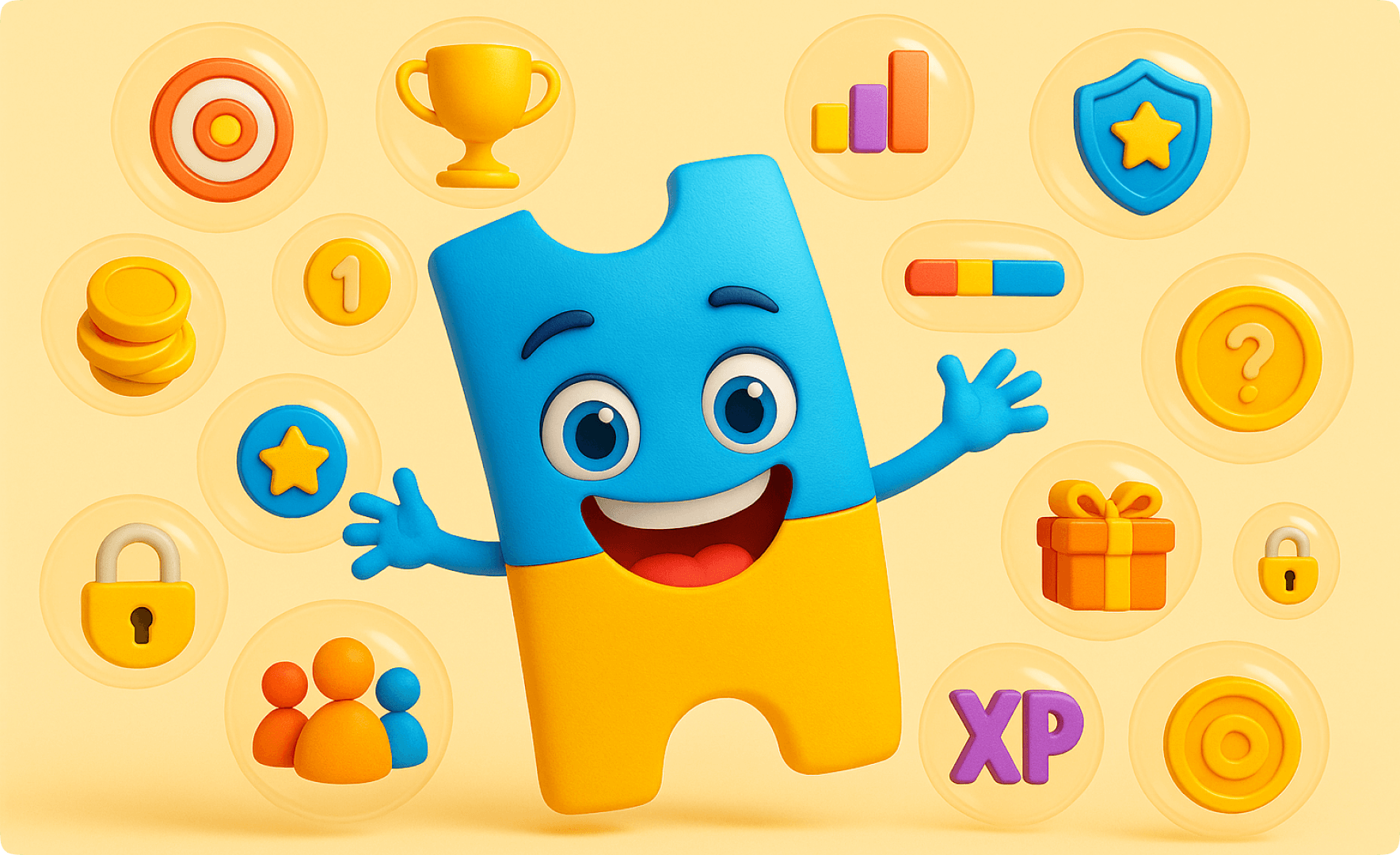
Custom Marketing Game Development vs Using Winday: Budget and Timeframes
Are you interested to know how marketing games are made and what’s the best way to build your very own game? Check out our guide for insights on game dev roadmap, prices & timeframe.
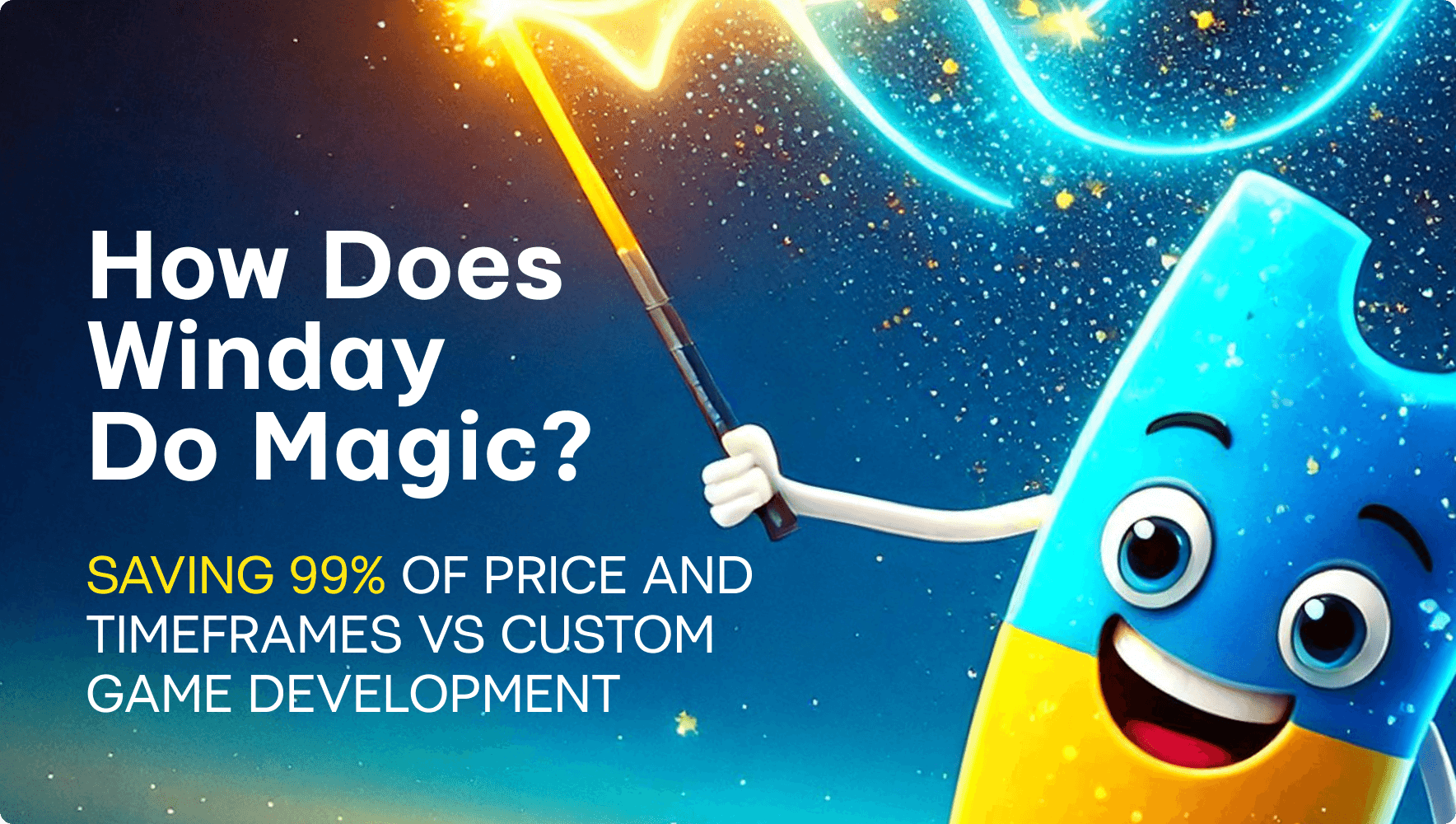
How McDonald’s Uses Gamification in Marketing (How You Can Too with Winday)
McDonald’s is one of the most successful brands using gamification globally. Learn what they do, why it works, and how you can apply the same gamified elements to boost your own brand.
